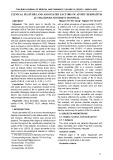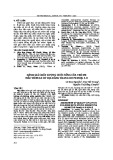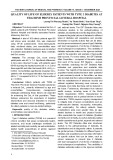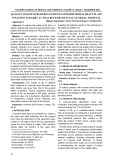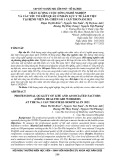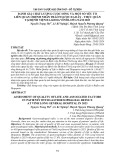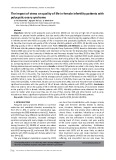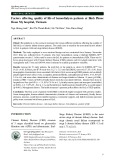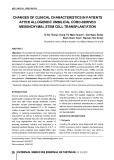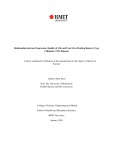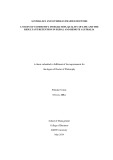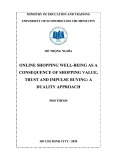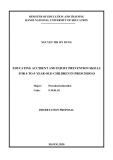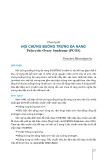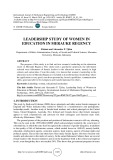
HUE JOURNAL OF MEDICINE AND PHARMACY ISSN 3030-4318; eISSN: 3030-4326
142
Hue Journal of Medicine and Pharmacy, Volume 14, No.6/2024
The impact of stress on quality of life in female infertility patients with
polycystic ovary syndrome
Le Thi Thuan My1*, Nguyen Thi Cuc1, Le Minh Tam1
(1) Hue center for Reproductive Endocrinolgy and Infertility,
Hue University of Medicine and Pharmacy Hospital
Abstract
Objectives: Women with polycystic ovary syndrome (PCOS) are not only at high risk of reproductive,
metabolic or physical health problems, but also easily suffer from psychological disorders such as stress,
depression, anxiety, this has been proven to lower quality of life. Determining the negative effects of stress
in infertile women with PCOS on quality of life is important and practically significant. This study aims to:
(1) Describe stress levels and quality of life in female infertility patients with PCOS. (2) Identify some factors
affecting quality of life in infertile women with PCOS. Materials and Methods: A cross-sectional study on
210 female infertile patients diagnosed with Polycystic Ovary Syndrome (PCOS) based on Rotterdam criteria
Holland 2003 who came for examination and treatment at Hue Center for Reproductive Endocrinology and
Infertility (HueCREI), Hue University of Medicine and Pharmacy hospital from May 2023 to May 2024. The
DASS-21 scale (Depression Anxiety Stress-21) and the MPCOSQ one (the modified PCOS health-related QoL
questionnaire) were used to survey the patient’s stress level and quality of life, respectively. The correlation
between stress levels and patients’ quality of life scores was analyzed using the Pearson correlation coefficient
(r). Comparing factors in terms of the diagnostic criteria for PCOS, other elements with quality of life, then
finding relationships and making discussion. Results: In total of 210 patients recruited in this study, there were
75 patients suffering stress at different levels from mild, moderate to severe and highly severe, accounting
for 21.0%, 10.5%, 3.3% and 1%, respectively. The average mPCOSQ score in terms of infertility factor was the
lowest, at 3.71 ± 1.31 points. The study found a strong negative correlation between the average score of
stress level based on the DASS-21 and the average score of quality of life based on the mPCOSQ (r= -0.861,
p<0.001). What is more, the quality of life score in terms of infertility illness was the lowest, regardless of
stress level (p<0.001). Furthermore, factors such as income level, BMI, acne and hirsutism have a statistically
significant association with the quality of life of female infertile patients with PCOS (p<0.05). Conclusion:
Stress has taken a toll on the quality of life in infertile women with PCOS. Particularly, of six domains related
to the quality of life in female infertile patients with PCOS, infertility problems were obtained the lowest
score no matter what stress level they are. On top of that, income, BMI and other factors such as acne,
hirsutism can have a significant implication of the quality of life in infertile PCOS female patients.
Key words: Polycystic ovary syndrome (PCOS), stress, quality of life, female infertility.
Corresponding Author: Le Thi Thuan My. Email: thuanmy746@gmail.com
Received: 25/10/2024; Accepted: 24/11/2024; Published: 25/12/2024
DOI: 10.34071/jmp.2024.6.20
1. INTRODUCTION
Polycystic ovary syndrome (PCOS) is a common
endocrine and metabolic disorder, accounting for
from 3% to 26% in women of reproductive age,
according to the 2003 Rotterdam criteria [1]. Patients
with PCOS have many different manifestations which
include menstrual disorders, increased androgen
secretion and polycystic ovary images on ultrasound
[2]. There are about 65-75% of women with PCOS
having hirsutism [3], 38-88% of women are obese
and overweight [4], approximately 30-40% of women
with PCOS having acne [5], and around 20% - 30% of
patients with PCOS coping with female pattern hair
loss (FPHL) [6].
The psychological implications caused by PCOS
can stem from dissatisfaction with changes in body
image and feminine identity related to obesity,
acne, hirsutism, baldness, irregular menstruation,
amenorrhea, fear and anxiety when suffering from
chronic illness. In addition, infertility as a result of
PCOS can cause negative emotions such as guilt,
shame, and low self-esteem in women, leading to
varying levels of stress, anxiety, and poor quality
of life. Some studies have documented that PCOS
worsens reproductive dysfunction, fertilization
failure and spontaneous abortion. Therefore, infertile
women with PCOS will be more likely to abolish
their treatment cycles and make treatment more
difficult. Symptoms of PCOS not only lead to anxiety,
suffering, and discomfort but can also lower the







